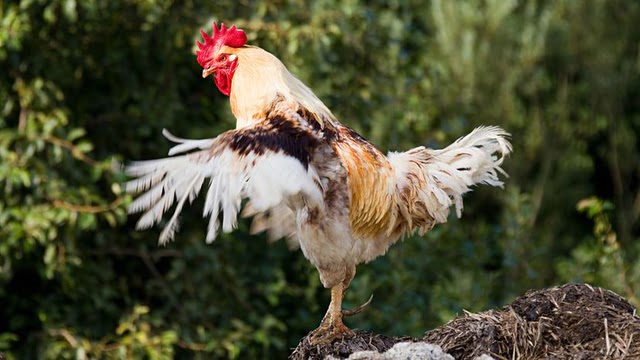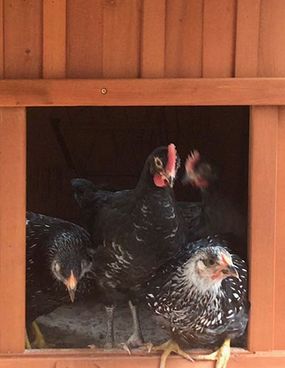Quck answer
It is possible for hens to transform into roosters due to a genetic abnormality called gynandromorphism. This occurs when the hen’s cells divide unequally during fertilization, resulting in a bird with both male and female reproductive organs. The bird may display physical characteristics of both sexes, such as male plumage on one side and female plumage on the other. The transformation from hen to rooster can also occur in response to a loss of a dominant male in the flock, as the hen’s hormonal levels change and cause a shift in sexual characteristics.
Wild Animals

On rare occasions, chickens can change their sexes. Image Source/Getty Images
Miss Lucille was a young hen who was living comfortably in Kristi Allen’s (not her real name) backyard chicken coop in Powder Springs, Georgia. Initially, everything seemed normal with the young exchequer leghorn cross. However, after observing her for a while, Allen noticed that Miss Lucille was growing a comb. Although both sexes of this breed can have combs, Allen’s instincts told her that something was not quite right, so she sought help from a local farmer.
“The farmer did all the checks to confirm that Miss Lucille was a ‘miss’,” Allen recalls. “She had no saddle feathers, did not show any aggression, did not jump or react in the presence of other hens or roosters, and when she was picked up by the farmer, she stuck her legs out straight and just lay there. These are all tricks that old-timers use to identify roosters since there’s no definitive way to tell until they mount another chicken or crow, aside from lab testing.”

Miss Lucille (center) before her transformation.
Kristi Allen
Miss Lucille had “failed” the rooster test. However, later on, Allen came home to a mess of feathers in the backyard, which was unusual since hens don’t usually molt until around 18 months. “She began acting more temperamental, but I attributed that to her molting, as it can be quite uncomfortable for chickens,” she says. “I was worried about her health.”
A New Dawn
Although there were certainly strange things going on with Miss Lucille, none of them were threatening to her health. When her feathers grew back, they were saddle feathers, like those found on roosters. Her hackles and tail feathers had also undergone some significant changes. “She went from being your typical hen to a rooster with beautiful, long tail feathers and pointy hackles. Her gait changed, and she was definitely at the top of the pecking order,” Allen says.
Further consultation advised a wait-and-see approach. One farmer told her, “Just because she now looked like a rooster didn’t mean she was one. I needed to wait until she crowed or mounted one of the hens.”
Ironically, Miss Lucille became more mellow and friendly. “But then her comb kept getting bigger and redder. For every indicator that she might still be a ‘she,’ there was another for her being a ‘he,’” she says.
Finally, the undeniable proof came at around 5 months of age –- the rooster literally crowed. “Every day the crow grew louder and stronger. It was official that Miss Lucille was now Mr. Lucille,” Allen says. “And to his credit, he assumed the role wonderfully. If the girls were low on water, he’d crow and let me know to get on it. He’d lead the charge up to roost at night. He’d wake us up with his song early each morning.”

Mr. Lucille transformed from a hen to a rooster, which is a rare and spontaneous occurrence. Out of 3,000 hens that were monitored, only 28 underwent sex reversal. The reason for this phenomenon is not completely understood, but it is believed to be connected to alterations in estrogen hormone action. The right ovary and oviduct regress during embryonic development, leaving the hen with only one functional ovary. If the left ovary is removed or becomes dysfunctional, the regressed right ovary may form an ovotestis, which secretes androgens that masculinize the female bird. The lack of estrogen changes the bird’s plumage, increases testosterone, and causes the growth of head ornaments, like the wattle and comb. However, the exact mechanism for avian sex determination is still unknown. If a hen becomes a rooster, the owner must accept that the bird will no longer produce eggs and may need to get a new hen for egg production. Mr. Lucille’s owner had to give him away to another rooster lover due to his uncontrollable crowing, but she is happy that he can now freely do his thing. It should be noted that the most aggressive chicken claims the top spot in the pecking order and acts as the protector of the flock. If there is a rooster present, he usually holds the position of chief chicken.
FAQ
1. What is the difference between a hen and a rooster?
A hen is a female chicken while a rooster is a male chicken. The physical differences between the two are quite distinct. Roosters are generally larger and more brightly colored than hens. They also have a larger comb and wattles on their head and neck, and long, pointed tail feathers. Hens are smaller and less colorful, with a smaller comb and wattles and shorter, rounded tail feathers.
2. Can a hen turn into a rooster?
Technically, no. A hen cannot change its genetic makeup from female to male. However, in rare cases, hens can exhibit male characteristics due to a hormonal imbalance or other genetic abnormalities. This can cause the hen to develop physical traits similar to a rooster, such as a larger comb and wattles, longer tail feathers, and even crowing.
3. What causes a hen to turn into a rooster?
A hen can turn into a rooster due to a genetic issue where the bird has both male and female sex organs, called a “gynandromorph.” This condition occurs when an egg with two nuclei is fertilized by two sperm, resulting in a bird with both male and female cells. The hormonal balance in the bird can then cause it to develop male or female physical characteristics, depending on which cells dominate.
4. Can a rooster lay eggs?
No, a rooster cannot lay eggs. Only female chickens, or hens, can lay eggs. The purpose of a rooster is to fertilize the eggs laid by the hens, which then allows the eggs to develop into chicks if they are incubated or kept warm.
5. How does a rooster fertilize an egg?
A rooster fertilizes an egg by mating with a hen. During mating, the rooster mounts the hen and transfers sperm to the hen’s oviduct, where it fertilizes the egg if one is present. The fertilized egg then develops into a chick if it is incubated or kept warm.
6. What is the purpose of a rooster?
The primary purpose of a rooster is to fertilize the eggs laid by the hens. Roosters also act as protectors of the flock, warning the hens of danger and defending them from predators. They also establish a pecking order within the flock, with the strongest and most dominant rooster at the top.
7. Are roosters necessary for egg production?
No, roosters are not necessary for egg production. Hens can lay eggs without ever mating with a rooster. However, if a rooster is present, the eggs may be fertilized, which can result in chicks if the eggs are incubated or kept warm.
8. Can a hen that turns into a rooster still lay eggs?
No, a hen that turns into a rooster cannot lay eggs. The physical changes that occur when a hen turns into a rooster include the development of male sex organs, which do not include the ability to lay eggs.





Leave a Reply